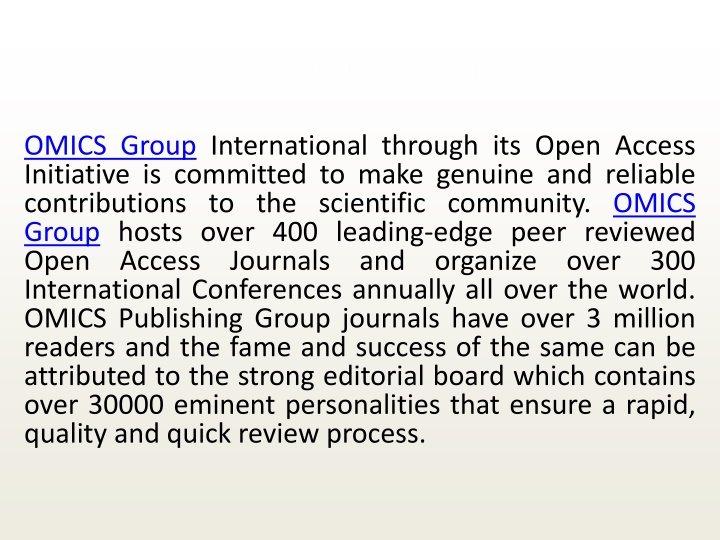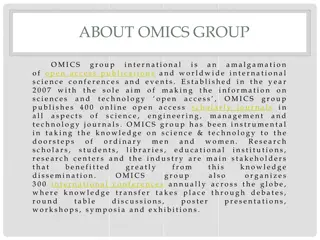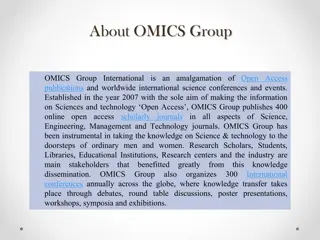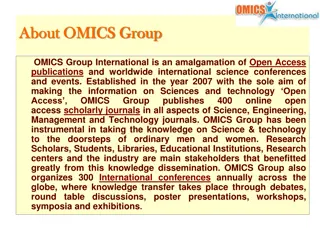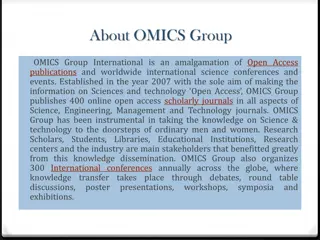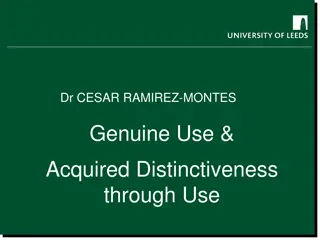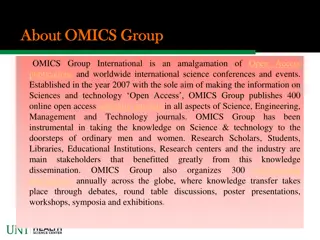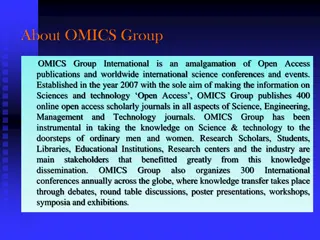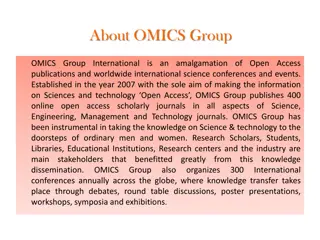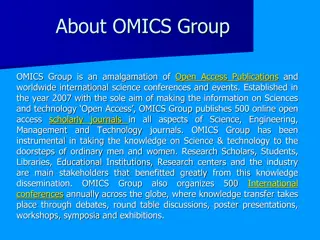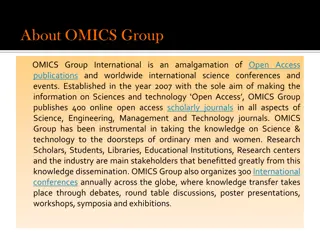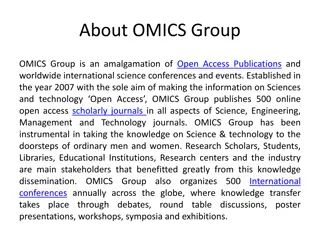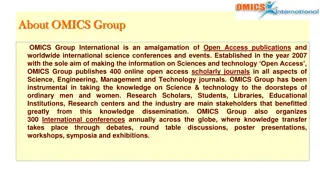Omics Group: Genuine Contributions to Scientific Community
OMICS Group, through its Open Access Initiative, hosts over 400 peer-reviewed journals and international conferences annually. With a strong editorial board, it ensures rapid and quality review processes. The group has organized 500 conferences worldwide, making it a global platform for networking and knowledge exchange. Their focus on healthcare information accessibility has led to collaborations with over 1000 International Societies. The content includes insights on topics such as Mid-Infrared Quantum Well Lasers and Absorption Spectroscopy, providing valuable information for scientists and researchers globally.
Download Presentation

Please find below an Image/Link to download the presentation.
The content on the website is provided AS IS for your information and personal use only. It may not be sold, licensed, or shared on other websites without obtaining consent from the author.If you encounter any issues during the download, it is possible that the publisher has removed the file from their server.
You are allowed to download the files provided on this website for personal or commercial use, subject to the condition that they are used lawfully. All files are the property of their respective owners.
The content on the website is provided AS IS for your information and personal use only. It may not be sold, licensed, or shared on other websites without obtaining consent from the author.
E N D
Presentation Transcript
About Omics Group OMICS Group International through its Open Access Initiative is committed to make genuine and reliable contributions to the scientific community. OMICS Group hosts over 400 leading-edge peer reviewed Open Access Journals and International Conferences annually all over the world. OMICS Publishing Group journals have over 3 million readers and the fame and success of the same can be attributed to the strong editorial board which contains over 30000 eminent personalities that ensure a rapid, quality and quick review process. organize over 300
About Omics Group conferences slide OMICS Group signed an agreement with more than 1000 International Societies to make healthcare information Open Access. OMICS Group Conferences make the perfect platform for global networking as it brings together renowned speakers and scientists across the globe to a most exciting and memorable scientific event filled with much enlightening interactive sessions, world class exhibitions and poster presentations Omics group has organised 500 conferences, workshops and national symposium across SanFrancisco,Omaha,Orlado,Rayleigh,SantaClara,Chicago,Philadel phia,Unitedkingdom,Baltimore,SanAntanio,Dubai,Hyderabad,Ban galuru and Mumbai. the major cities including
September 10, 2014 Optics-2014, Philadelphia 3 The A,B,C s of Mid-Infrared Quantum Well Lasers Yves Rouillard, Guilhem Boissier and Gr goire Narcy IES Laboratory Universit Montpellier 2 France
Absorption spectroscopy: The case of methane 4 slide 2.31 m 1.65 m 3.31 m 7.53 m Stretching Overtone Stretching + Bending Stretching Fundamental Bending Fundamental 1E-14 -1.cm2) 3.31 m (Mir Infrared): . Fundamental vibration . Maximum of absorption 1E-15 -1.molecules 1E-16 1E-17 CH4 1E-18 2.31 m: . Linear combination of vibrations . Absorption 40 times weaker Line strength (cm 1E-19 1E-20 1E-21 1.65 m (Near Infrared): . Overtone of 3.31 m vibrations . Absorption 200 times weaker 1E-22 1E-23 1 2 3 4 5 6 7 8 9 10 ( m) (Hitran database)
Some interesting ranges for other hydrocarbons 5 slide Methane: Peak at 3.31 m 1 0.9 0.8 Ethane: Half maxima at 3.28 m and 3.49 m 0.7 Transmittivity 0.6 0.5 0.4 Propane: Half maxima at 3.31 m Methane 0.3 Ethane 0.2 and 3.51 m Propane 0.1 Acetylene 0 Acetylene: 2 peaks at 3.03 and 3.06 m 2.9 3 3.1 3.2 3.3 3.4 3.5 3.6 3.7 Wavelength ( m) (Chemistry WebBook, NIST) The 3.0-3.1 m range is interesting for Acetylene sensing The 3.3-3.4 m range is interesting for natural gas sensing
A History of GaInAsSb/AlGa(In)AsSb Laser diodes 6 1980: DH laser at 1.8 m in pulsed mode at 20 C (NTT, S. Kobayashi) 1988: DH laser at 2.0 m in cw mode at 20 C (Ioffe, A. Baranov) 1988: DH laser at 2.34 m in cw mode at 20 C (Lebedev, A. Bochkarev) 2004: QW laser at 3.04 m in cw mode at 20 C (Univ. Munich, C. Lin) 2005: QW laser at 3.26 m in pulsed mode at 20 C (Univ. Munich, M. Grau) 2010: QW laser at 3.40 m in cw mode at 20 C (S. Univ. New York, T. Hosoda) 3.4 3.2 3.3 m limit 3 2.8 pulsed ( m) 2.6 2.4 2.2 cw 2 T=20 C Soichi Kobayashi 1.8 + 5 years 1.6 1975 1980 1985 1990 1995 2000 2005 2010 2015 Year The history of mid-infrared laser diodes can be summarized as a race toward long wavelengths
Mid Infrared lasers: Spectroscopic applications 7 slide QW DFB at 3.06 m: For measuring C2H2in C2H4 (polyethylene plants, 40% of plastics) S. Belahsene et al. Phot. Tech. Lett. 22-15, 1084 (2010) U. Montpellier + Nanoplus Siemens Laser Analytics - LDS 6 QW DFB at 3.37 m: Useful for measuring CH4and C2H6 (portable detectors able to discriminate between naturally occuring methane and natural gas) Requirement for a portable detector: Pelec< 1 W With a DFB at 3.37 m at 10 C : Pel= 0.15 A x 1.6 V + 0.1 W ( -Peltier) = 0.34 W L. Naehle et al. Electron. Lett. 22, 47-1 (2011) U. Montpellier + Nanoplus GMI DPIR (device at 3.37 m was a prototype)
Record Threshold Current Densities (Jth) 8 10000 Results by: Turner 1998 (50 A/cm at 2.05 m ) 1000 Jth (A/cm ) Vizbaras 2011 (120 A/cm at 2.6 m) Belenky 2011 (545 A/cm at 3.3 m) 100 Vizbaras 2012 (1450 A/cm at 3.7 m) and many others 10 2 2.5 3 3.5 4 Wavelength ( m) From 2.05 m to 3.7 m, Jthis multiplied by 30 !
Best Characteristic Temperatures (T0) 9 slide 160 140 120 100 To (K) 80 60 40 20 0 2 2.5 3 3.5 4 Wavelength ( m) At 2.3 m, T0equals 95 K but plummets to 25 K at 3.3 m !
Searching for the culprit in degradation of performances 10 slide 1.00E-25 InAs 3.54 m 1.00E-26 1.00E-27 C (cm6.s-1) GaInAsSb 2.3 m GaInAsP 1.55 m 1.00E-28 GaAs 0.87 m Bulk materials 1.00E-29 GaSb 1.72 m 1.00E-30 0 0.2 0.4 0.6 0.8 1 1.2 1.4 1.6 Eg (eV) The Auger recombination coefficient C is multiplied by 44 from 2.3 m to 3.54 m in bulk materials Auger is the most likely culprit !
Why does Auger increase at long wavelength (small Eg)? 11 E slide = exp a C C . Auger coefficient depends on an activation energy, Ea: 0 kT . The activation energy Eais proportional to the bangap energy Eg: m + m + = = CHCC a CHLH a c m lh m E E E E g g 2 m m m c hh hh c lh ( ) m + = CHSH a if so m E E E g so g so 2 m m hh c so . In the CHCC process, Eais the minimal possible kinetic energy of the hole involved in the process: 3.8 3.8 3.4 3.4 3.0 3.0 2.6 2.6 Energy (eV) Energy (eV) 2.2 2.2 1.8 1.8 1.4 1.4 High Eg Small Eg 1.0 1.0 0.6 0.6 0.2 0.2 -0.2 -0.2 Ea Ea -0.6 -0.6 -0.2 -0.1 0 0.1 0.2 -0.2 -0.1 0 0.1 0.2 k//( -1) k//( -1) Small Eg=> Small Ea
What is the value of the activation energy ? 12 slide . Calculated values for lasers at 2.6 m made from GaInAsSb: m = = CHCC a 0.040 eV c m E E lattice matched GaInAsSb (such as in a heterostructure laser) : Eg= 0.47 eV, mc= 0.025 m0, mhh= 0.270 m0 g + m c hh Calc. CHCC = CHCC a 0.170 eV E +1.5 % strained GaInAsSb (such as in a QW laser) : mhh= 0.044 m0 = = CHSH a CHLH a because out ruled Rq : 0.725 eV E E E g so Strain increases the activation energy and allows the operation of QW lasers in the mid-infrared . Experimental values for QW lasers at 2.3 m and 2.6 m made from GaInAsSb: 1/T (K-1) D. Garbuzov et al. Appl. Phys. Lett. 74, 2990 (1999) 0.0025 0.0027 0.0029 0.0031 0.0033 0.0035 0.0037 8 Exp. Ea= 0.152 eV CHCC is the most likely process in QW lasers emitting in the mid-infrared CAuger(a.u.) 2.6 m 2.3 m 0.8
How does Auger impact the threshold current ? 13 Threshold current density: slide ( ) q N L 2 3 = + + w w J AN BN CN th th th th i . Nw: number of quantum wells (typically, 2) . Lw: thickness of quantum well ( 10 nm) . i: internal quantum efficiency ( 75 % at 2.3 m) . A: monomolecular recombination coefficient ( 1.108s-1 at 2.3 m) . B: radiative recombination coefficient ( 4.10-10cm3.s-1 at 2.3 m) C: Auger recombination coefficient ( 2.10-28cm6.s-1at 2.3 m) Threshold carrier density: Transparency carrier density: Effective carrier density: m kT m kT N N + g tr tr = = , c hh N N = exp i m N N + = N N 1 e e c v 2 2 L L c v th tr w w 0 0.070 9.E+17 . Ntr: transparency carrier density ( 3.1017cm-3 at 2.3 m) . i: internal loss ( 5 cm-1at 2.3 m) . m: mirror loss ( 12 cm-1for a 1 mm-long diode) . go: ( 30 cm-1) y = 0.0421x + 0.005 R2 = 0.998 8.E+17 0.060 7.E+17 0.050 6.E+17 Ntr (cm-3) me (m0) 0.040 5.E+17 4.E+17 0.030 3.E+17 0.020 2.E+17 0.010 1.E+17 The threshold current density depends on 10 parameters ! 0.000 0.E+00 0 0.5 1 1.5 0.5 1.0 1.5 2.0 2.5 3.0 3.5 Eg (eV) ( m)
A quantity proportional to the radiative current density 14 Spontaneous emission observed from the tilted facet of a laser emitting at 2.38 m below threshold: slide ( = ( ) ) spon r K I Spontaneous emission rate: spon + = Integrated spontaneous emission rate: ( ) R r d spon spon 0 = 2 B N The integrated spontaneous emission rate Rsponis proportional to Jrad= q NwLwBN !
In search of the A, B, C coefficients 15 = slide We have: R k N spon = ( ) + + 2 3 ' J k AN BN CN Let s normalize ????? sothat ?????= 1 at threshold + + ( ) 2 3 J AN BN CN = = + + 2 Therefore: " " k k A BN CN N R spon ? ?????as a function of ?????is equivalent to plotting ? + ?? + ??2as a function of N Plotting 1200 3.23 m J/normalized square root of Rspon (A/cm ) 1000 On this plot, a laser dominated by, 800 . monomolecular recombination will be shown as a flat line 600 y = 653x2+ 91x + 272 y = A 400 2.83 m . radiative recombination, as a slope y = 147x2+ 119x + 8 y = BN 2.38 m 200 . Auger recombination, as a power function y = 33x2+ 87x + 6 0 y = CN 0 0.2 0.4 0.6 0.8 1 1.2 Normalized square root of Rspon
Determining the proportion of Auger at threshold 16 There are many things to be learned from the parabolas: . For example, the proportion of the Auger recombination current at threshold: slide Lambda ( m) 2.38 2.83 3.23 Parabola (A/cm ) y = 33x2+ 87x + 6 y = 147x2+ 119x + 8 y = 653x2+ 91x + 272 Jth (A/cm ) 126 275 1017 JAuger(A/cm ) 33 147 653 JRad (A/cm ) 87 119 91 JMono (A/cm ) 6 8 272 Proportion of Auger 26% 54% 64% . And more than that, the value of the A, B & C coefficients ! Jthdepends on 10 parameters, Let s use Jtrinstead because the transparency carrier density Ntrdepends only on the electron and hole masses ( ) q N L 2 3 = + + w w J AN BN CN tr tr tr tr i 3000 10000 Amplified spontaneous emission due to gain Power recorded normally to the facet 2500 1000 2000 Power recorded from the the tilted facet Jth Jtr = 31 A/cm 100 P (mV) P (mV) 1500 10 1000 Jth = 126 A/cm 1 Pure spontaneous emission 500 0 0.1 0 50 100 150 200 0 50 100 150 200 J (A/cm ) J (A/cm )
Determining the A, B, C coefficients 17 After calculating Ntr, we can determine A, B, C: slide Lambda ( m) Jtr (A/cm ) JAuger(A/cm ) JRad (A/cm ) JMono (A/cm ) Ntr (cm-3) A (s-1) B (cm3.s-1) C (cm6.s-1) 31 2.38 5 24 3 3.3E+17 4.5E+07 1.1E-09 6.8E-28 52 2.83 19 29 4 2.9E+17 4.7E+07 1.2E-09 2.5E-27 356 3.23 153 35 168 2.7E+17 1.4E+09 1.1E-09 1.8E-26 1.00E-25 QW 3.23 m 1.00E-26 QW 2.83 m 1.00E-27 QW 2.38 m C (cm6.s-1) 1.00E-28 Bulk materials 1.00E-29 1.00E-30 0 0.2 0.4 0.6 0.8 1 1.2 1.4 1.6 Eg (eV) From 2.4 to 3.2 m, the Auger coefficient is multiplied by 25 in QW lasers
Conclusion 18 slide We have developped a method based on recording the spontaneous emission from the tilted facet of a laser We determined the A, B, C coefficients of mid-infrared quantum well lasers from our experiments: . At 2.4 m, the Auger coefficient C equals 6.5E-28 cm6.s-1 . At 2.8 m, C = 2.5E-27 cm6.s-1 . At 3.2 m, C = 1.8E-26 cm6.s-1 This exponential rise explains the increase of the threshold currents of mid-infrared quantum wells
Let Us Meet Again slide We welcome all to our future group conferences of Omics group international Please visit: www.omicsgroup.com www.Conferenceseries.com http://optics.conferenceseries.com/
